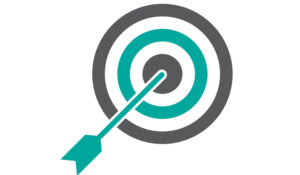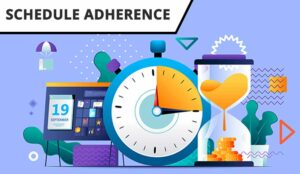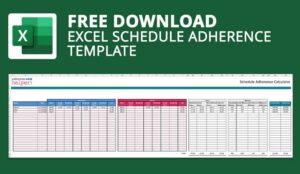Andy Turner introduces us to adherence management, providing some pointers about how to get your employees to stick to their schedules.
How do we strike a balance to ensure that agents are meeting their quality and other standard metrics, but at the same time ensure that agents are getting a fair deal in terms of workload and adequate break time and that they are all pulling together in the same direction? Adherence could be the answer.
What Is Adherence?
If you look in a dictionary the definition of adhere is to be conscientious in supporting or following something or somebody. In terms of a contact centre, adherence is all about measuring your agents’ accuracy in following their individual time schedule.
Examine the make-up of your agent’s average working day – excluding lunch break, it may add up to seven and a half hours. Built into the day will be a couple of drinks and comfort breaks, there may also be short breaks to help agents re-charge after difficult calls.
The metric is defined as a percentage of the working day where an agent is available for calls – if a working day is seven and a half hours long, 80% adherence would correspond with an agent being available for calls during 6 hours of the day.
So, the way to improve efficiency is through adherence to the schedule, meaning that agents endeavour to adhere to their assigned exceptions and breaks during the day. This helps contact centre resource planners forecast workloads more effectively – if you know that a certain number of agents are in position to answer calls at a set time, the call flow will run more smoothly.
It is common sense to see that improved adherence to schedules transfers to higher productivity. If 80% adherence equates to an agent taking calls for 6 hours in a working day, 90% adherence would stretch the available time to 6 hours and 45 minutes – a huge leap in available work time which could result in full-time equivalent (FTE) efficiencies.
Many organisations have workforce management software solutions in place which automatically measure the time that an agent is logged on and available to take calls.
For more on this link between adherence and WFM, read our article: The Relationship Between Adherence and Forecasting
Adherence In Practice
We worked with a major public sector organisation to investigate and improve adherence management, examining three of their contact centres to first measure the adherence level, so we could then suggest a benchmark figure to achieve.
To get a ‘real life’ view we asked agents to complete a daily activity log for two weeks which tracked the breaks they took during their day. We discovered that the primary reasons for non-adherence to schedule were taking comfort breaks, missing breaks and breaks running too long; lateness in logging-on and technical issues with the agent’s systems. The average adherence level was as low as 82%, which equated to 6 hours and 4 minutes agent availability compared to a total working day of 7 hours and 24 minutes.
For our customer, we were asked to set a benchmark adherence figure which was based on allowing time for comfort breaks, call over-runs and everyday training – and we set this at 49 minutes per day. This equates to an adherence level of 89%. The new benchmark took on board all of the idiosyncrasies of this organisation, such as how long it takes for agents to get drinks (refreshments), the amount of over-running calls, etc. One of the main benefits of managing adherence is the positive contribution it brings to your agents in terms of greater consistency in occupancy levels and fairness. By defining this adherence allowance, agents clearly understand how much time they have to spend on everyday ‘down-time’.
It acts as a fair, transparent benchmark for all – agents who typically never take their breaks are now dutifully required to take, wherever possible, their assigned breaks and additional adherence allowance if they need it. Those who always have extended breaks will now have to reign in their excess. If your benchmark adherence figure is very high, say in the upper 90% category – your agents will get too stressed; too low a figure and your agents will spend ages in the canteen, losing their motivation.
To quickly calculate adherence through an Excel spreadsheet, check out our: Free Schedule Adherence Tool
Communication and Involvement
Getting started with adherence management requires communication and involvement with your agents. The core principle to improving adherence is to ensure the process from start to finish is fair and up-front for all.
As we worked with our customer we consulted widely, involving agents in establishing the benchmark, conducting workshops, consulting with management and team leaders, producing materials to show progress. It is also essential to work with your human resources team. Adherence management is an interesting area for HR, as it touches on so many areas of their remit and can genuinely help with sickness and attrition levels, as well as help improve workforce morale.
We met with over 150 team leaders working with our customer, who all understood how adherence management will help in their everyday lives and produce a better working environment, as well as achieving the organisation’s performance and financial goals.
Achieving Adherence Day In, Day Out
So, you’ve researched, consulted and engaged with your agents and have established your adherence benchmark. But how can you achieve this day in, day out? Team leaders are the key to driving an adherence policy, they know the individual agents and the way they like to work, their strengths and weaknesses, the agents who take long breaks and those who do not take a break at all. As with any measure, most agents will be somewhere in the middle, happily hitting the benchmark. So it comes down to tackling the exceptions. Getting serious about adherence will help with this as it becomes clear who the individual agents who flaunt the benchmark are, allowing team leaders to take action in terms of coaching and management.
Contact centre performance changes minute by minute. We all try to continually match call demand with agent resource, but we all know from time to time something will go wrong. Call demand suddenly soars and you need all hands on deck.
In this situation where you need everyone, what happens to adherence management? This is where team leaders need to use their common sense and a belief in fairness. Get over the call peak and ensure agents can re-coup their break time or any other pulled exception as soon as possible.
In our experience, adherence management is a clear route to two targets which you maybe would not put together: producing a happier, fairer more transparent contact centre as well as delivering cost savings and improved efficiency.
Although more immediate metrics such as utilisation, average handling time, service level and first-call resolution typically take precedence, adherence management definitely needs to follow hot on their heels and ideally, be designed in sequence with the other metrics.
For more on the topic of adherence management, read our articles:
- How to Manage and Improve Schedule Adherence
- How do I Calculate… Schedule Adherence?
- Top Tips for Improving Attendance and Adherence
Author: Jo Robinson
Published On: 3rd Mar 2010 - Last modified: 11th Dec 2020
Read more about - Workforce Planning, Adherence, Genesys, Key Performance Indicators (KPIs), Measurement, Occupancy, Utilisation



















What’s the different between occupancy rate and utilization rate; and how they reflect on agent’s productivity?
Horses for courses, different terms for the same thing. Seat productivity is another. It’s actual time an agent is productive OR the time a seat is productive (if hot desking) during opening hours. Now this may not directly relate to any call handling metrics at all, especially if there are back office or white – e-mail functions associated with the role. An agent is also ‘productive’ if you have them off the phone for coaching or training, however, in these cases their seat isn’t.
Hope it helps..
DaveA
I would like to know if an agent does not take his scheduled breaks at all, would that impact schedule adherence?
I just need confirmation on this one. On our agent scorecard, Schedule adherence and lost hours% (absenteeism) are part of it. If the company will implement that an absence will equate to 0% schedule adherence for the day aside from getting a 100% lost hours% wouldn’t that be considered a double jeopardy? Aren’t schedule adherence and attendance 2 separate metrics?
Yes they are two separate metrics, but attendance does play a part in schedule adherence as if you go sick you cannot adhere to the schedule.